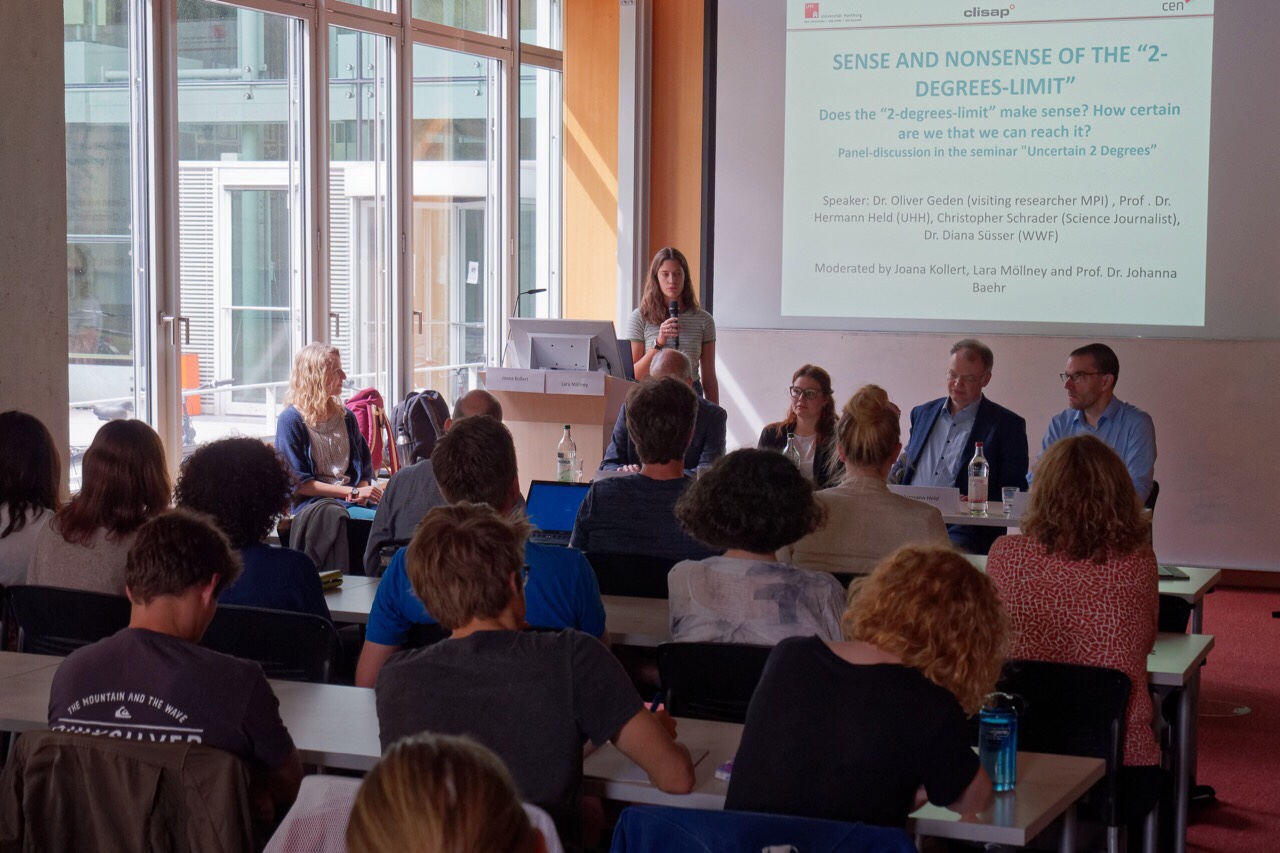The panel discussion on July 5 concluded the interdisciplinary ‘Uncertain 2 Degrees’ seminar through the questions: ‘Does the 2-degrees-limit make sense? How certain are we that we can reach it?’. The panellists debating about the sense and nonsense of the 2-degrees-limit included Dr Oliver Geden (visiting researcher MPI), Prof Dr Hermann Held (UHH), Christopher Schrader (science journalist) and Dr Diana Süsser (WWF).
After a brief introduction, the panellists were each given the opportunity to report on their personal experience with the 2-dgerees-limit. While Mr Schrader highlighted that the framing of the terminology as a ‘limit’ rather than a ‘target’ is important, Mr Held went on to elaborate on the history of the limit. Most economists would give other targets obtained from a simple cost benefit analysis (more in the range of supposedly optimal 3 to 3.5 degrees), whereas the 2-degrees-limit may be understood as a mathematical expression of a given value system. This feature is to be distinguished from other functions that may be attached to it. Ms Süsser from the WWF continued by mentioning the concept of planetary boundaries in which climate change is only one variable among many. As a statement to ignite further debate she argued that focusing on uncertainties might be too dangerous as it might limit political will to trigger action. As a trained anthropologist researching on climate policies, Mr Geden finally shifted the attention of the audience towards the inconsistencies between an agreed-upon temperature limit and a lack of country commitments to stay below this limit. He criticised the temperature target as a substitute for action, rather than a prerequisite. According to his ideas, the ambiguities surrounding the debate around 2 degrees are crucial to keeping the limit alive, because they give policymakers additional leeway in negotiations.
Following these initial statements, plenty of questions arose from the audience. The first one asked for a more precise definition and an explanation of the meaning of the 2-degrees-limit. Mr Held explained that the limit was created in a phase of little knowledge about possible impacts. The metric on which the limit rests is therefore given by natural temperature fluctuations, thereby rendering it a result of the precautionary principle while still acknowledging known impacts. Mr Geden added that there is no precise definition, which is greatly favoured by policymakers who can thus exploit relating ambiguities and still remain deeply committed to the target. Subsequently, the debate evolved into questions of individual responsibilities and how the 2-degrees-limit could be translated into this field. Ms Süsser highlighted the sector decarbonisation approach that addresses individual firms, whereas Mr Schrader stressed that it is crucial for citizens to act politically and not just confine their actions to ethical consumerism or similar. Moving to the next question whether communication between science and the general public is the core problem that can explain sluggish progress in climate policy, he argued that there are fundamental psychological limits to the number of worries a person may have. In order to trigger action, a problem needs to be perceived as PAIN – personal, abrupt, immoral, now. Whereas many of these criteria are fulfilled by threats such as terrorism, climate change does not achieve a high score in this regard. This implies that, despite all scientific knowledge about the impacts, the risks climate change poses are simply not tangible enough to cause a large-scale outcry.
Beyond these, plenty of other interesting questions popped up in the course of the debate, touching issues such as negative emissions technologies, other target metrics to spur immediate action and the general problem of an expertocracy in the climate debate.
In a final statement, all panellists were asked for their opinion on the sense or nonsense of the 2-degrees-limit. Mr Schrader mentioned the need for an easily understandable target for the media to communicate, whereas Ms Süsser stressed that climate change is only one among many sustainable development goals. Along the same line of argumentation as in his opening statement, Mr Held argued that the limit makes sense as a mathematical representation of a given value system, largely shared by him. Finally, Mr Geden concluded that temperature targets (or limits) are here to stay but that they might not be a good metric to spur action, which might be easier to achieve by a more actionable net-zero emissions target.

